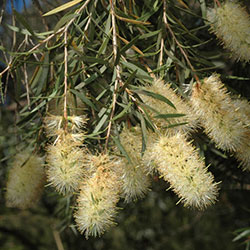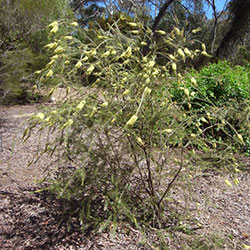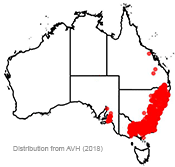Callistemon sieberi
 |
 |
River Bottlebrush
 Callistemon sieberi occurs naturally from the Mt Lofty Ranges in South Australia to around Warwick in south-east Queensland, extending across central and eastern Victoria and the tablelands and coastal regions of NSW. It grows in riparian shrublands, dry sclerophyll forests, gorges, and sand ridges between flood channels.
Callistemon sieberi occurs naturally from the Mt Lofty Ranges in South Australia to around Warwick in south-east Queensland, extending across central and eastern Victoria and the tablelands and coastal regions of NSW. It grows in riparian shrublands, dry sclerophyll forests, gorges, and sand ridges between flood channels.
Callistemon sieberi is an attractive, easy to grow plant which could be used in a shrubbery, as a screen or informal hedge or as part of a mixed border. It is usually a medium sized shrub around 2.5 m tall but can vary from 0.6 m to a small 8 m tree. It is fast growing with fine soft foliage and a showy flower display which attracts nectar feeding birds. It will tolerate drought, neglect and hard frosts, although the cultivar 'Sugar Candy' is reported to tolerate only light frosts. The branches are pendulous and the new growth is pale slivery pink, which is an attractive feature in its own right. Flowers are usually cream, but there are cultivars with pink flowers (e.g. 'Sallyann', 'Sugar Candy'). Flowering is prolific and long lasting, occurring from November to March. This plant is not fussy about soil texture, structure or pH. It prefers a moist soil, but will tolerate dry conditions.
Use an organic or native plant fertiliser to encourage plant vigour, especially during establishment. Extra water during establishment will also improve growth rate. Plants should be tip pruned regularly when young to encourage a bushy habit. When plants have attained the desired size they can be headed back once a year to encourage new growth. The seed capsules of this callistemon are quite small (5mm diameter), and do not tend to remain on the stems for long so there is no need to prune them off after flowering as with many other Callistemon species. This plant may be trained to a small tree by retaining the central leader and removing lower branches. Old leggy specimens can be rejuvenated by giving them a hard prune – prune all branches back to a height of around half a metre.
Callistemon sieberi prefers a sunny aspect but can also be grown in part shade. In heavy shade it will become leggy and flowering will be reduced. It is also not suitable for narrow situations.
Seed germinates readily but is known to be short-lived. However, because of the wide variation in features it is recommended that propagation be conducted vegetatively. Very pendulous specimens with pink flowers are usually most desirable horticulturally, so cuttings from these individuals should be taken from semi-hard wood in late autumn or early winter, but also in spring. Cuttings have been reported as easy to strike by ANBG staff, however it has been reported as difficult to strike by some sources. Bottom heat and misting improves the strike rate.
Callistemon sieberi has no major pest and disease problems. Webbing caterpillars may show up from time to time, but this plant has a low susceptibility to this pest. If noticed the webbed bags should be pruned off and destroyed. Most Callistemon species can be affected by scale, thrips and sawfly larvae. White oil or other horticultural oils can be used to control scale and knock down thrips numbers. A heavy, persistent infestation can be treated with Spinosad, which is also effective on sawfly larvae.
Judith Ferneley, Volunteer Botanical Training Program Participant 2018
Name meaning: Callistemon sieberiCallistemon - from Greek kalos, beauty, and stemon, stamen, referring to the showy stamens of the flower sieberi - after F.W.Sieber, an early nineteenth-century Czech botanist |
References:
Brophy, J., Craven, L., & Doran, J. (2013) Melaleucas: their botany, essential oils and uses. Canberra: Australian Government.
Canberra Botanic Gardens (1976) Growing Native Plants Vol 6. Canberra: Australian Government Publishing Service.
Earl, G., Stelling, F., Titcumb, M., & Berwick, S. (2001) Revegetation guide for the Goulburn Broken Catchment. Melbourne: Department of Natural Resources and Environment Victoria.
Keith, D. (2017). Australian Vegetation. Great Britain: Cambridge University Press.
Percival, J. (2018) Horticulturist, Australian National Botanic Gardens. Personal Communication.
Stewart, A. (2016) Callistemon sieberi 'Sugar Candy' – Bottlebrush, Gardening with Angus. Available at http://www.gardeningwithangus.com.au/callistemon-sieberi-sugar-candy-bottlebrush. [Accessed February 2018]. Wrigley, J., & Fagg, M. (1993) Bottlebrushes, paperbarks & tea trees. Sydney: Angus & Robertson.
![An Australian Government Initiative [logo]](/images/austgovt_brown_90px.gif)

